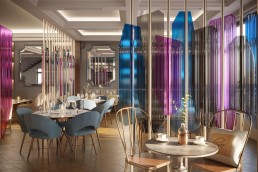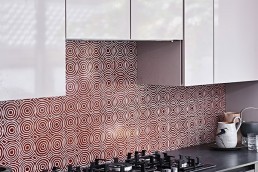Lasvit launches new Art Wall series
Czech glassmaking and design company Lasvit has expanded its product portfolio to introduce three new interior walls as part of the new product line Lasvit Art Walls.
Designed by Wanda Valihrachová, the new architectural pieces – called Impasto, Curtain and Tapestry – are intended for both the hospitality and public sectors.
As well as being aesthetically pleasing, the walls have functional properties such as partitioning space, dampening sound and partial obfuscation. In the post-pandemic world, the glass partitions can provide functional design whilst facilitating social distancing.
Van Gogh’s Impressionist impasto as an interior art feature
The Impasto wall is named after the famous painting technique used by post-Impressionist painter Vincent Van Gogh, which was later adopted by the Expressionists, such as Willem de Koonig. The impasto technique involves applying paint on the surface in thick dabs, usually strong enough to make the artist’s paint strokes visible. The Impasto interior walls looks as if thickly painted by a brush.
Since its first appearance, the Impasto technique has served multiple purposes. It makes light refract in the interior and gives the entire space a dash of expressivity. In painting, impasto was used to give a two-dimensional plane a third dimension and an almost sculptural feel.
The swirling brush strokes make Impasto vibrant with energy and make for a more colourful and beautiful interior environment. Just like Expressionist painting, Impasto is visually quite striking so fits best with rather streamlined and minimalist interiors.
Available in ten colour combinations ranging from grey to light blue, Impasto can be customised to complement any interior.
Impasto can also can be combined in almost any pattern. Impasto features six standard components which vary in height, width and method of fastening (pipe or wire). Lasvit also offer four types of fastening.
Curtain: Streamlined partitions
In the past, theatre curtains were designed to not only fulfil the purpose of decoration, but also to mask backstage preparations. Similarly, Lasvit’s Curtain gives any interior a sense of privacy without becoming closed in on itself.

The defining features of Curtain are its elegant colour scheme – clear, grey, smokey and blue-grey – which are accessorised with three glass finish variants. The first comprises long vertical strips, the second is reminiscent of draperies, while the third is a subdued grid structure, as if rough textile were imprinted on the glass.
Lasvit offers the Curtain Art Wall in one standardised dimension, mounted on a stainless pipe. The size of the glass component itself is set at 2.2 meters. Thanks to their individual fastening to the floor, the individual pieces are self-standing, and they can also be set up in an arc.
One of Curtain’s most interesting features is the ability to turn the individual components at the drop of a hat, and thus create either more or less intimacy in the space at any given moment. In this way, Curtain can accommodate the interior’s function throughout the day.
Tapestries of artful glass are uniquely attractive
The Tapestry Art Wall takes its name from woven images, so-called “tapestries” which make simple textiles into storytelling pieces of art. Tapestries have often decorated the walls of palaces, castles and chateaus, and have become the pride of museums such as the Louvre or the Metropolitan Museum in New York, as well as being prized possessions of the Vatican’s Sixtine Chapel collections. In Lasvit’s contemporary design idiom, the Tapestry wall can adorn world-class hotels, concert halls, theatres, residencies with high ceilings or any other vast space.

Drawing heavily on the legacy of craft and manual work, the Tapestry Art Wall consists of bent glass which winds its way throughout, much like a thread through a woven tapestry, to give the impression that the glass is rippling. Tapestry offers three types of structures – vertical stripes, drapery and grid, with glass elements sized at 60 x 40 centimetres.
With three types of fastening, Tapestry is a fitting solution for a wide range of interiors and uses. The first option is fastened to the floor, which allows it to reach a height of 3 meters. The second option is to fasten it onto a wall, with Tapestry functioning as a form of tiling, and the third allows it to be fastened to both the floor and ceiling.
Related Posts
10 November 2020
Lasvit launches Icons collection
28 June 2016
Aboriginal art tiles unveiled
1 June 2015




